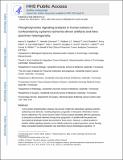Phosphotyrosine Signaling Analysis in Human Tumors Is Confounded by Systemic Ischemia-Driven Artifacts and Intra-Specimen Heterogeneity
Author(s)
Slebos, R. J. C.; Shaddox, K.; Wiles, K.; Washington, M. K.; Herline, A. J.; Levine, D. A.; Liebler, D. C.; Gajadhar, Aaron; Johnson, Hannah; White, Forest M.; ... Show more Show less
DownloadWhite_Phosphotyrosine Signaling.pdf (1.176Mb)
OPEN_ACCESS_POLICY
Open Access Policy
Creative Commons Attribution-Noncommercial-Share Alike
Terms of use
Metadata
Show full item recordAbstract
Tumor protein phosphorylation analysis may provide insight into intracellular signaling networks underlying tumor behavior, revealing diagnostic, prognostic or therapeutic information. Human tumors collected by The Cancer Genome Atlas program potentially offer the opportunity to characterize activated networks driving tumor progression, in parallel with the genetic and transcriptional landscape already documented for these tumors. However, a critical question is whether cellular signaling networks can be reliably analyzed in surgical specimens, where freezing delays and spatial sampling disparities may potentially obscure physiologic signaling. To quantify the extent of these effects, we analyzed the stability of phosphotyrosine (pTyr) sites in ovarian and colon tumors collected under conditions of controlled ischemia and in the context of defined intratumoral sampling. Cold-ischemia produced a rapid, unpredictable, and widespread impact on tumor pTyr networks within 5 minutes of resection, altering up to 50% of pTyr sites by more than 2-fold. Effects on adhesion and migration, inflammatory response, proliferation, and stress response pathways were recapitulated in both ovarian and colon tumors. In addition, sampling of spatially distinct colon tumor biopsies revealed pTyr differences as dramatic as those associated with ischemic times, despite uniform protein expression profiles. Moreover, intratumoral spatial heterogeneity and pTyr dynamic response to ischemia varied dramatically between tumors collected from different patients. Overall, these findings reveal unforeseen phosphorylation complexity, thereby increasing the difficulty of extracting physiologically relevant pTyr signaling networks from archived tissue specimens. In light of this data, prospective tumor pTyr analysis will require appropriate sampling and collection protocols to preserve in vivo signaling features.
Date issued
2016-09Department
Massachusetts Institute of Technology. Department of Biological Engineering; Koch Institute for Integrative Cancer Research at MITJournal
Cancer Research
Publisher
American Association for Cancer Research
Citation
Gajadhar, A. S. et al. “Phosphotyrosine Signaling Analysis in Human Tumors Is Confounded by Systemic Ischemia-Driven Artifacts and Intra-Specimen Heterogeneity.” Cancer Research 75.7 (2015): 1495–1503.
Version: Author's final manuscript
ISSN
0008-5472
1538-7445